"No other technology has impacted us like the mobile phone."
About the Shared Rural Network
What is the Shared Rural Network (SRN)?
The Shared Rural Network (SRN) is transforming mobile coverage, countrywide. The project was developed by the UK’s four mobile network operators (MNOs) with support from Government. The programme has already made 4G mobile broadband available to 95% of the UK. Additionally, the operators have extended mobile coverage to an additional 280,000 premises and for people in cars on an additional 16,000km of the UK’s roads, boosting productivity and investment in rural areas.
The project consists of MNOs investing to extend their coverage by upgrading their existing networks, working together on shared infrastructure and building new sites, with new government-funded masts being built to target areas with no mobile coverage from any operator. Through its work, the SRN will increase the parts of the UK that get a mobile service from all operators from 66% to 82%, improving consumer choice.
Each of the MNOs’ individual networks will cover 90% of the UK, enabling rural businesses and communities to thrive.
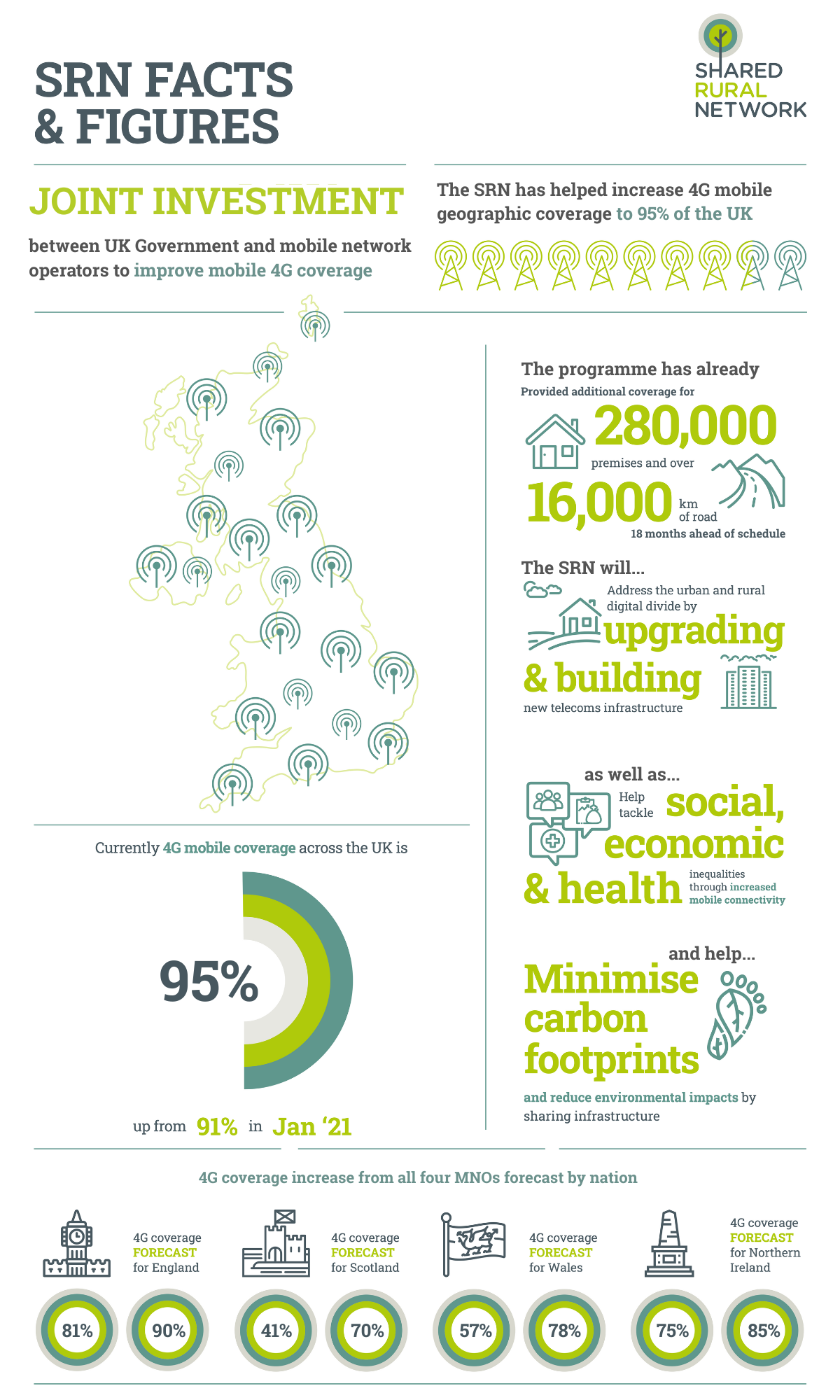
The Shared Rural Network – An Overview
Programme Progress:
PNS Progress
The Partial Not Spot (PNS) element of the programme is funded and delivered by the mobile operators. In September 2024, Ofcom published an update on the compliance of the UK’s four mobile network operators with their Shared Rural Network coverage obligations. You can read the report here on the Ofcom website. In November 2024, Ofcom completed a further assessment of information provided by Three to confirm that these requirements have been met. The full update statement can be read on the Ofcom website.
TNS Progress
On the publicly funded element of the programme, which involves providing coverage in the total-not-spots (TNS), progress continues with planning applications now being submitted across Scotland. Build on these masts has begun in some areas and work will continue until early 2027.
EAS Progress
As part of the Shared Rural Network programme, UK Government funding is being made available to the Home Office and mobile network operators (MNOs) to upgrade Extended Area Service (EAS) masts being built or upgraded as part of the Emergency Services Network (ESN) to make them usable by the four MNOs to offer commercial connectivity as well as emergency services coverage.
The Shared Rural Network – The Benefits
The benefits of reliable 4G mobile connectivity are far reaching and have positive impacts on many aspects of day-to-day life. There are many personal and commercial benefits, as well as positive impacts on healthcare, education, tourism, remote working, and accessing online services, to name a few. The Shared Rural Network will help those who live and work in rural communities to achieve their full potential through improved mobile connectivity.
Here are some helpful information sheets that provide an overview of the programme and the benefits of 4G connectivity. Click on the links below to learn more about how the Shared Rural Network will make a difference to those living and working in rural communities across the UK:
Forecast Coverage Improvements by Region
The Shared Rural Network has already ensured geographic coverage from at least one operator to 95% of the UK over a year ahead of schedule, broadening consumer choice for mobile services in rural areas.
Across the UK, there will be a significant increase in the areas where all four operators deliver coverage, from 69% to 82% by the end of the programme. The areas forecast to benefit from the Shared Rural Network are illustrated in the below map.
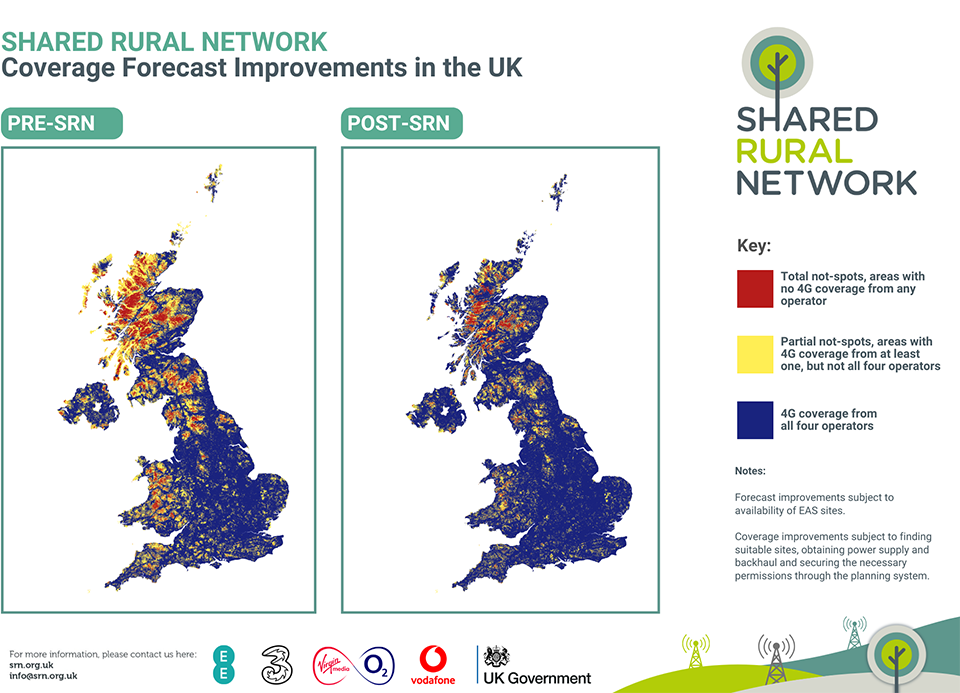
As a result of the Shared Rural Network, 4G in all four home nations of the UK coverage will increase as follows:

% figures rounded to whole figures. Pre SRN figures taken from Ofcom 2019 Connected Nations Report published 13 December 2019. Current coverage taken from Ofcom Connected Nations Spring Update 2025 published May 2025.
Progress against these targets will be measured by Ofcom. Visit the Ofcom website for more information about licence obligations and methodology.
Please visit the relevant section to view the forecast coverage improvement on a map, and broken down by region, for each of the four nations: England, Northern Ireland, Scotland and Wales.
About the data
The coverage improvement forecast is based on the initial radio plan, which was submitted to Ofcom in June 2020, and is subject to change as the programme progresses. Pre-SRN figures are taken from Ofcom 2019 Connected Nations data. All % figures are rounded to whole figures. The forecast improvements are subject to availability of Extended Area Service sites. Coverage improvements are subject to finding suitable sites, obtaining power supply and backhaul and securing the necessary permissions through the planning system.
England
In England, coverage from all four operators will rise to a minimum of 90%, up from 81%. Coverage from at least one operator will increase from 97% to 98% by the end of the programme.
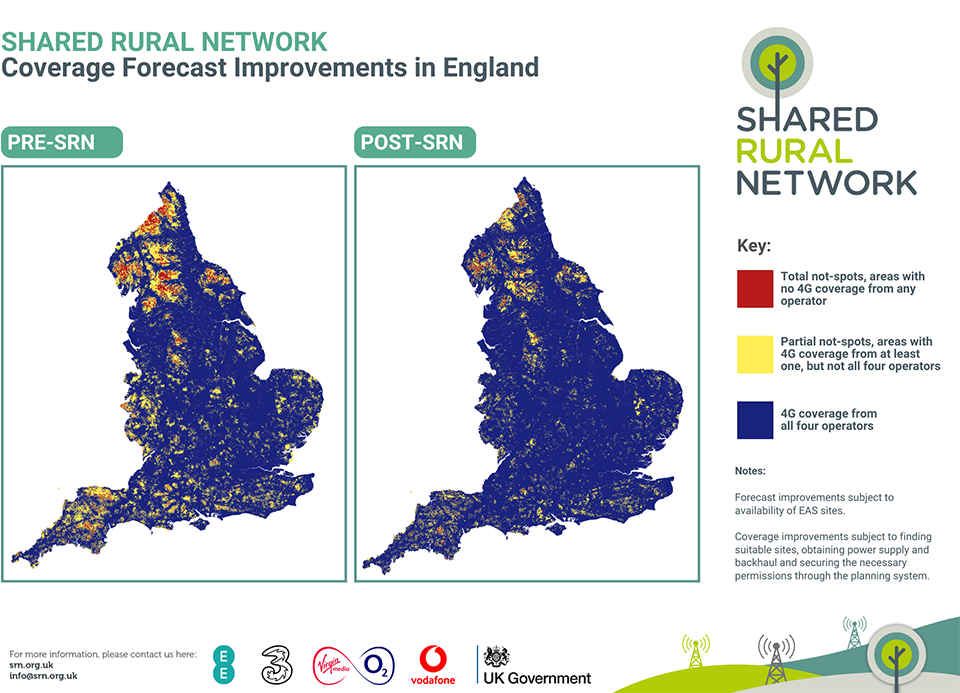
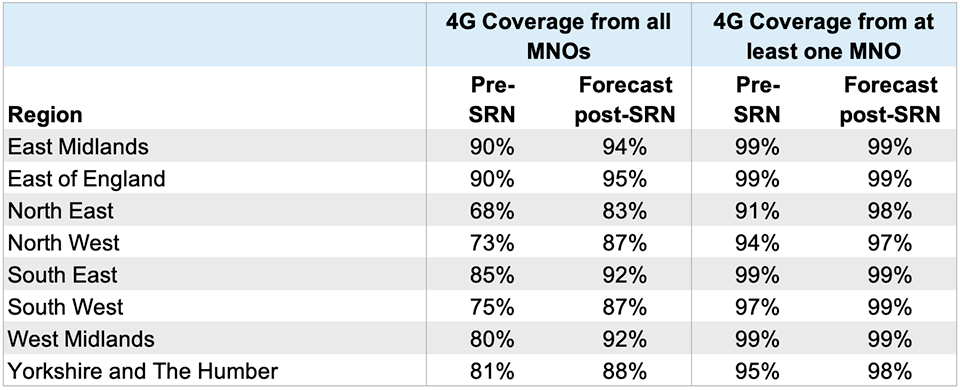
Northern Ireland
In Northern Ireland, work on the SRN has now completed. Thanks to the programme, coverage from all four operators has risen to 85%, up from 75%. Coverage from at least one operator has increased from 97% to 98%.
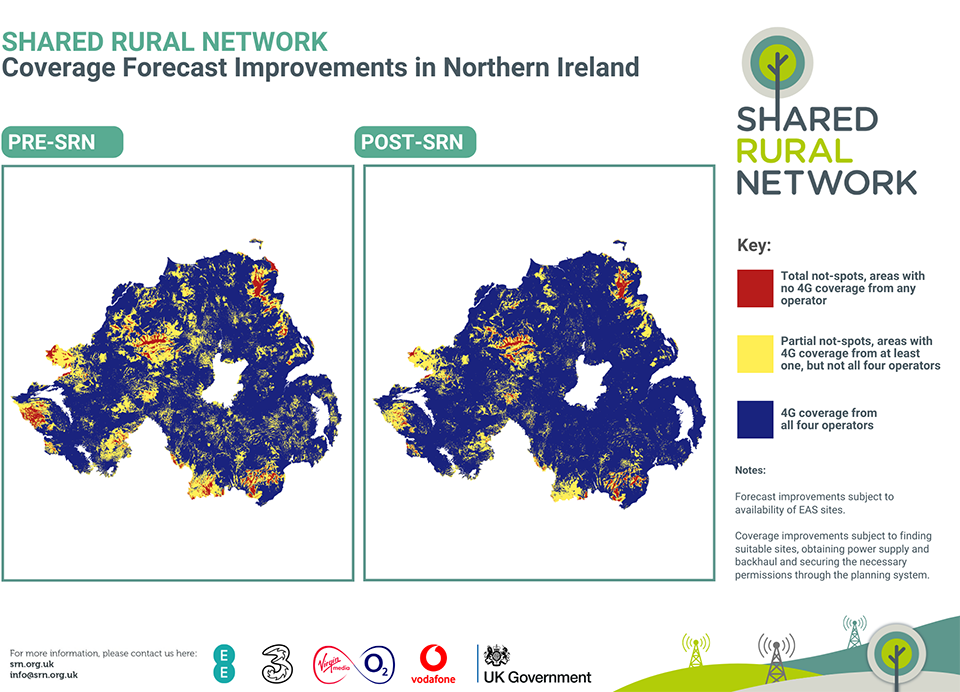
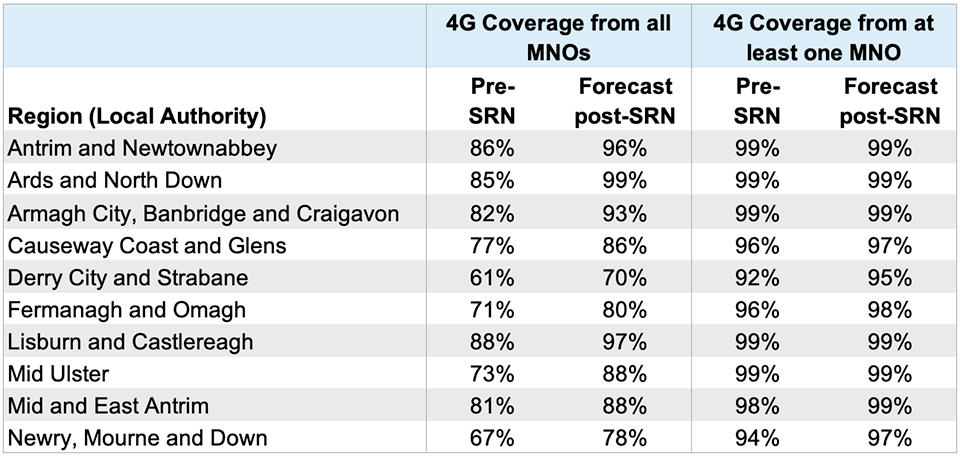
Scotland
In Scotland, coverage from all four operators will rise to a minimum of 70%, up from 41%. Coverage from at least one operator will increase from 80% to 91% by the end of the programme.
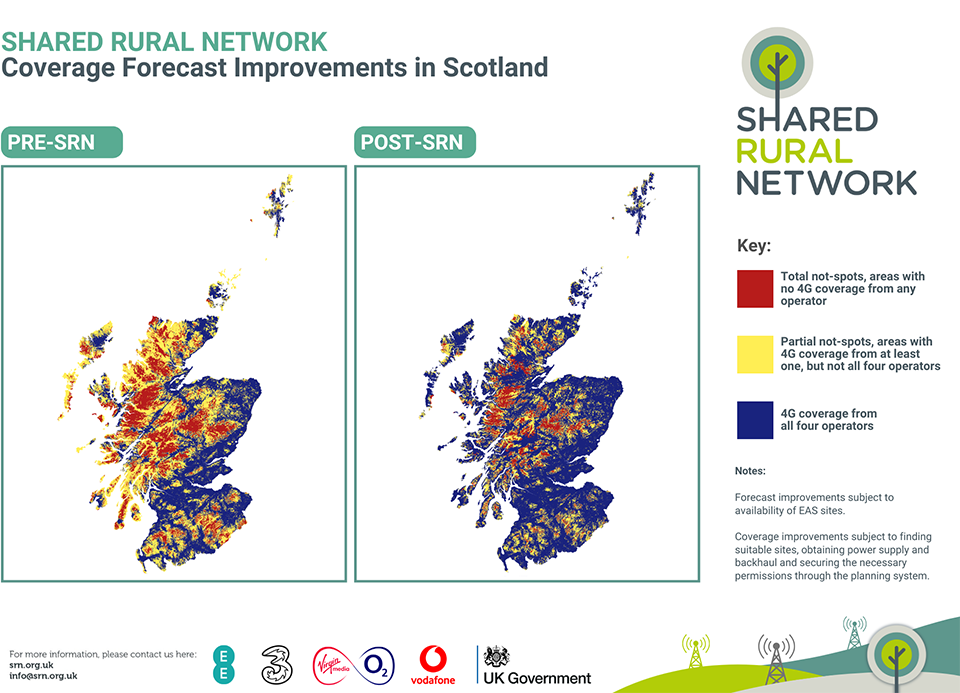
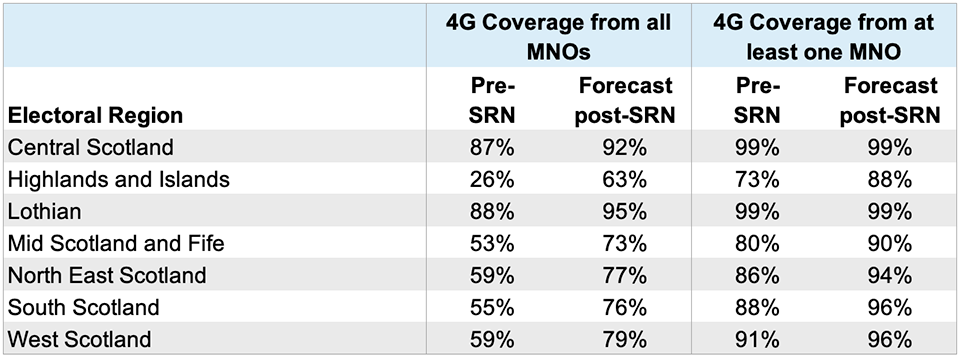
Wales
In Wales, coverage from all four operators will riseto a minimum of 78%,up from 57%. Coverage from at least one operator will increase from 90% to 97%by the end of the programme.
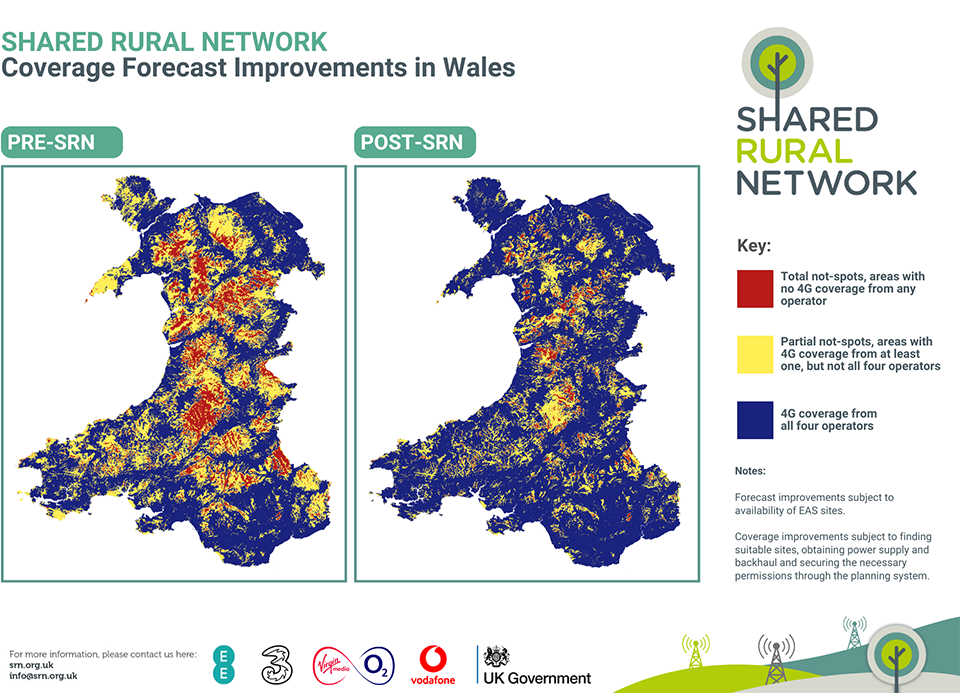

Questions and Answers about the SRN
How will the 95% coverage target be reached?
To deliver the programme, the mobile network operators (MNOs) have invested in upgrading their existing network, sharing infrastructure and building new phone masts. This has significantly reduced the number of partial not-spots – these are areas where there is coverage from at least one, but not all operators.
The Government is providing additional investment to tackle total not-spots – those hard-to-reach areas where there is currently no coverage from any operator.
When will improvements be delivered?
The full benefits of the SRN will be delivered over the life of the programme. However, additional coverage has already been delivered under the partial not spot (PNS) element of the programme, as well as improvements made under the Extended Area Service (EAS) element of the programme which makes use of existing government infrastructure normally only used for emergency calls. Improvements made under the total not spot (TNS) element of the programme have started to roll out and will be completed by the programme deadline of early 2027.
What is 4G?
Fourth generation mobile services, known as 4G, give people faster access to the internet and make it much quicker to surf the web on your mobile, tablets and laptops.
Rural businesses will be able to work more efficiently, for example by accepting electronic payments, being in better contact with potential and existing clients, and facilitating flexible and remote working for their employees.
What is a partial and total mobile not-spot?
A partial mobile not-spot is a geographic area served by at least one, but not all four mobile network operators (MNOs). Currently 80.67% of the UK is served by all four operators with 4G, up from 66% in 2019.
A total mobile not-spot is a geographic area that receives no 4G coverage from any MNO. Currently 9% of the UK, by geography, is in a 4G total not spot.
Where can I find out which areas already have 4G coverage, and which are in partial or total not-spots?
You can find out the available coverage from the four mobile network operators (MNOs) in any given area using Ofcom’s mobile coverage checker. You can also visit the 4G coverage checkers on each of the mobile operators’ websites.
EE: https://coverage.ee.co.uk/coverage/ee
Three: http://www.three.co.uk/Discover/Network/Coverage
O2: https://www.o2.co.uk/coveragechecker
Vodafone: https://www.vodafone.co.uk/network/status-checker
What happens if I am not a customer of the four, big mobile service companies - EE, O2, Three and Vodafone?
EE, O2, Three and Vodafone are the only mobile network operators (MNOs) in the UK that have a physical network.
Any other mobile providers will be using one of these four mobile operators’ networks to offer mobile services to their customers through that MNO’s network. Improving mobile coverage for the four MNOs means improved mobile coverage for customers of all mobile service providers.
Coverage improvements
What percentage of the country will get coverage from all four operators and by when?
All four mobile network operators (MNOs) - EE, Three, VMO2 and Vodafone – have worked together to deliver combined geographic coverage from at least one operator to over 95% of the land mass of the UK.
People living in Scotland and Wales will see the biggest coverage improvements because the landmass coverage in these nations is starting from a lower base. You can see the maps and tables above for coverage forecast improvements by nation.
What will be the impact of the SRN in Scotland?
In Scotland, the SRN will see 4G coverage from all four operators rise to a minimum of 70%, up from 41% in 2020, and coverage from at least one MNO increase to 91%, allowing rural business to prosper and rural communities to thrive.
What will be the impact of the SRN in Wales?
In Wales, the SRN will see 4G coverage from all four operators rise to a minimum of 78%, up from 57% in 2020, and coverage from at least one MNO increase to 97%, allowing rural business to prosper and rural communities to thrive.
What will be the impact of the SRN in Northern Ireland?
In Northern Ireland, the SRN will see 4G coverage from all four operators rise to a minimum of 85%, up from 75% in 2020, and coverage from at least one MNO increase to 98%, allowing rural business to prosper and rural communities to thrive.
What will be the impact of the SRN in England?
In England, the SRN will see 4G coverage from all four operators rise to a minimum of 90%, up from 81% in 2020, and coverage from at least one MNO increase to 98%, allowing rural business to prosper and rural communities to thrive.
Why are the targets lower for Scotland and Wales?
The SRN will see both Scotland and Wales get the greatest boost to 4G coverage from all four mobile network operators, from 41% to 70%, and 57% to 78%, of landmass respectively, improving coverage where people live, work and travel.
Funding
How much will it cost?
The SRN will be funded jointly by the mobile network operators (MNOs) and the Government. Collectively, the MNOs will contribute £532 million to the SRN, in order to address partial not-spots, a geographic area with 4G coverage from least one, but not all four mobile network operators. The Government will provide additional investment to provide new mobile masts in areas with no 4G coverage.
Environmental considerations
What will be the environmental impact of the SRN?
By sharing infrastructure, the SRN will reduce the carbon footprint associated with achieving improved mobile coverage, because fewer mobile sites will need to be installed, operated and maintained than would otherwise be the case. What’s more, by providing better mobile connectivity to rural businesses, more services can be digitised in rural areas, reducing the carbon footprint of businesses. For example, business owners can increase the number of virtual meetings, reduce the number of face-to-face meetings and cut back on unnecessary travel.
How will you minimise the impact on the rural landscape?
To provide 4G coverage to areas where people do not have it today - typically in more rural areas - new mobile masts will have to be built. Under the SRN, new masts will be shared between multiple network operators, reducing the number of new masts required overall, and minimising the impact on the landscape. Operators will also be upgrading sites to deliver more coverage from their existing network. To achieve the same coverage targets without sharing infrastructure would require a far greater number of masts to be built.
All new mast developments will follow local planning processes.
For further information, please contact:
Gareth Elliott, Head of Policy and Communications, Mobile UK
ge@mobileuk.org, 07887 911 076





